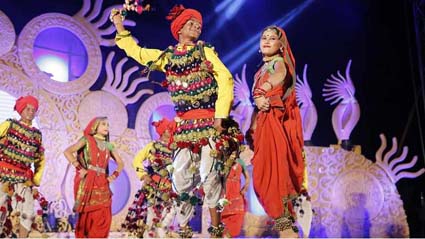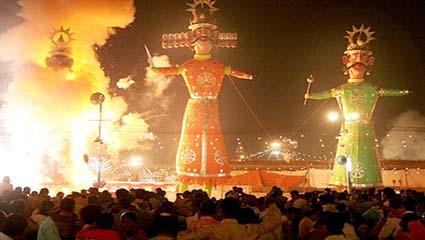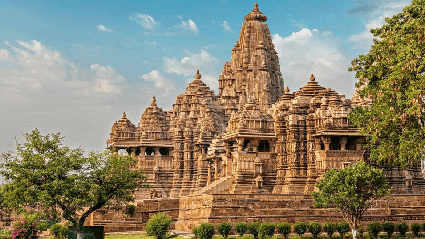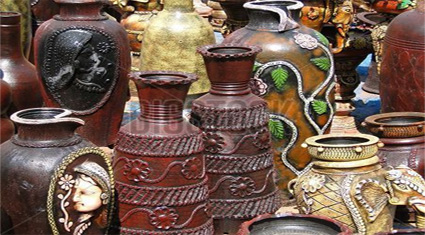Madhya Pradesh is the heart of India. It doesn't matter whether you are an art admirer, food fanatic, dancing dazzler or a jewellery junkie, this place is your dream pilgrim. The land jewellery by the rich states of Rajasthan, Gujarat, Uttar Pradesh, Maharashtra, and Chhattisgarh. Apparently, a blend of all cultures was meant to colour in the state. Originally known as Malwa, the place has nurtured some epic rulers and warriors as well, like Emperor Ashoka, Chandragupta, Vikramaditya, Harsha Vardhan, Raja Bohoj and many others. A long, revealing history forged by these great men is preserved in book and ink.
The residents here are very generous as well; they will not mind giving you a lift to your hotel, just ask once. The place has a subtropical climate, much like the North India. The state has an intact connectivity with railway and airways; tourist would not find travel distress of any sorts.
Madhya Pradesh has a culturally defined cuisine which varies from region to region. The meals include both Veg and Non-Veg dishes depending on the locality. The traditional dishes like kusli, lavang lata, jalebi, pilaf with peas, Indori puri palak ki, baflas, kebabs, and biryani are ruling the heart and the stomach of our country.
The aroma of these dishes is itself magical. The food shifts with every shade of season of the year. It’s like every particular district specialize in something, the overall flavors encountered in the surrounding states are homed in one! Bhopal will feed you with its spicy kebabs, biryani, korma, fish, meat, and keema while the places like Indore and Gwalior will serve some creamy dishes prepared from milk, Bafla is one from many cooked from wheat, ghee, and milk. The pure vegetarians could have a taste of Bhutte ki kee, a dessert prepared with milk and corn. The various tribes and cultures have their impression over these splendid cuisines; one could feel one step closer to understand the culture by having them.
. 
|
|
Dhotiforms the traditional costume of the men folk of Madhya Pradesh. The headgear or the turban popularly known as Safa is a distinct feature of the men. Safa or the head cloth is
generally prevalent in the eastern regions and the Paga or the turban is preferred by the people living in the western parts of the state. In addition the men's attire is also constituted by a
white or black jacket called Bandi or Mirzai usually worn by men living in Bundelkhand and Malwa. The myriad colours of this traditional costume of the men of Madhya Pradesh, gives
the men a radiant and dignified appearance. Tribal men are usually seen in a langot when they are at work but during any public appearance or on occasions they are seen with shortsized
Dhotis. Lehenga and Choli along with an additionalstrip of cloth called Orni or Lugra which is worn around the head and shoulders forms the most common attire of the
womenfolk of Madhya Pradesh. But sariis also common among the ladies due to modernization. The women folk also adorn themselves with traditional ornaments. Some of the favorite
and traditional colors among the women of Madhya Pradesh are red and black. Madhya Pradesh is famous for the Bandhani cloth.

|
|
Music of Madhya Pradesh is rich and vibrant encompassing the rich heritage of musicians. The culture of Madhya Pradesh, in true sense, is extensively recognised for its musical extravaganza and dancing rhythms. Folk songs, songs of Indian classical music genre are equally popular among music lovers. In Bastar, the Muria and Sing Maria tribes are well-known for the songs namely relo. The region is also fructified by dhankul songs colligated with evoking Danteshwari, a goddess, and the 'chait parah'. In Jagdalpur, leha songs are famous. These are ritual song sung during the departure from near and dear ones. During festivals, the swaying tunes of songs in accompaniment with bansuri, harmonium, chastise hearts both young and old.
The ambience of frenzy is even more heightened by the sophisticated steps of the dancing troupes. The colourful Maria Gonds of Bastar region fete their important events by dancing. The most popular dance form is the outstanding wedding dancing, called the Gaur is worth a watch. Tribal dances like Phag, Lota dance and various stilt dance styles are also prevalent. Dressed up in coloured clothes, the tribal population dance and hum melodious numbers thus depicting various aspects of socio-political and cultural scenarios. In nutshell, these bonanzas create a magnificent aura to its audiences both at home and abroad.

|
|
Festivals, too, enrich the culture of Madhya Pradesh. No one can claim to have known the region fully without identifying its festival jamboree. The region of Madhya Pradesh is the locale of fairs and festivals, which also becomes its style mantra. In other words, culture of Madhya Pradesh is incubated due to exquisite festival celebrations. Apart from celebrating all other Indian festivals like Holi, Dussehra, the tribal festivals and fairs are also observed in full vigour and merrymaking. Revelry, drinks and alien amusement like cock fighting, dancing label these tribal festivals in Madhya Pradesh. 'Kalidas Samaroh', 'Tansen Samaroh' and a dance fete in Khajuraho are celebrated, in great fiesta, with vast number of avid participants. Religious festivals too are observed with veneration. In West Nimar and Jabua regions of Mandhyanchal, a colourful festival called Bhagoria Haat is feted by the Bhils and Bhilalas tribes. Kumbha Mela is the biggest religious congregational fair of the Hindus and has known celebration from many centuries. The celebration of Kumbha Mela sees the union of millions of devotees, monks and religious saints from all corner of India, making the festival the largest of all Hindu fairs. Besides Chaitra fair the Dhup Dehi ka Mela of Hirapur the Ramnavami fair and the Gal Yatras are feted at various places in Madhya Pradesh region.

|
|
Culture of Madhya Pradesh is a pleasant amalgamation of Hindus, Jains, Christians, Muslims, Buddhists, and Sikhs. Moreover, the tribal communities of the state comprise diverse tribes like Oraon tribe, Kol tribe, Bhil, Gond tribe, Bhilala tribe, Muria tribe and Korkens, to name a few. These people belonging to several religions and ethnic backgrounds reflect the concept of Indian secularism and add to the animated cultural froth of the state. The eastern side of the state is dominated by the Oraons; most of them have now converted to Christianity. Most of the people in Madhya Pradesh are Hindus. There are, however, sizeable minorities of Muslims, Jains, Christians and Buddhists. There is also a small Sikh population. Hindi language is the main and the official language of Madhya Pradesh. Dialects of the language, such as Bundelkhandi, Malwi and Chhattisgarhi language, are spoken all over the state. Urdu language, Marathi language, Sindhi language, and Gujarati language are also commonly spoken here thanks to the mix of people.

|
|
Arts and crafts of Madhya Pradesh illustrate the tribal art form merged impeccably into the tradition of the people residing in Madhya Pradesh. People can find a vast diversity of arts and crafts in Madhya Pradesh. The arts and crafts give an idea; divulge hereditary skills and replicates craftsmanship of the local people. Arts and crafts incorporates bamboo work, dolls and toys, metalwork, carpet weaving, ornaments and jewellery, pottery, stone-carving, paintings, printing and woodcarving. The region of Madhya Pradesh looms large in lush textiles and rural handiworks. The people treasure handloom Chanderi sarees and Maheshwari saree. Madhya Pradesh is a hub of 'erotic' artistries and beautiful architectural works. Tribal craftsmen are skilled in metal wares and aesthetic objects. Tourists from world wide step into the region and explore its artistic treasures. Nature lovers too throng the dense forests and wild life sanctuaries that have proliferated in Madhyanchal. As a consequence, in different cities of Madhya Pradesh, hotels, pubs, restaurants, thus, are constructed to meet these demands of infiltration of tourists in great numbers through out the year.

|
|







